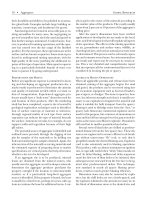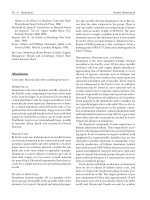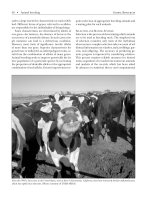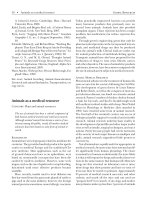Encyclopedia of Global Resources part 4 docx
Bạn đang xem bản rút gọn của tài liệu. Xem và tải ngay bản đầy đủ của tài liệu tại đây (215.82 KB, 10 trang )
A
Abrasives
Category: Mineral and other nonliving resources
Abrasives comprise a large number of both naturally
occurring minerals and rocks and manufactured
products. In many cases these manufactured products
have largely replaced their natural counterparts.
Some, such as diamond, are rare; others, including
sand and sandstone, are found abundantly in na-
ture. Allfind uses in the home or in industrybecause of
their characteristic hardness.
Background
Because the abrasives category encompasses a great
variety of materials, their worldwide distributions are
highly varied. Some, such as garnet and emery, are ob-
tained from only a few localities. Others, such as sand
and sandstone, are found on all continents, in all geo-
logic settings, and in rocks representing all geologic
ages.
Use of all the abrasives reflects in some manner the
characteristics of hardness. That property is utilized
in cutting and drilling tools, surface polishing materi-
als, and blasting media. The largest user ofabrasives is
the automobile industry. Abrasives, both natural and
synthetic, are used to perform one of four basic func-
tions: the removal of foreign substances from surfaces
(“dressing”), cutting, drilling, and comminution (or
pulverizing) of materials. Most abrasives lie toward
the upper end of the Mohs hardness scale. With re-
spect to one another, however, they can be catego-
rized as hard, moderate (or “siliceous”), or soft.
Hard Abrasives
The hard abrasives are diamond, corundum, emery,
and garnet. Diamond, the hardest naturally occur-
ring substance (10 on the Mohs scale), is normally
used in three size categories: stone, bort, and powder.
Only a small fraction of the diamond stones produced
by mining are of gem quality. All others, as well as
those produced synthetically (together referred to as
industrial diamonds), are used in various industrial
applications, including diamond saws, rock-drilling
bits, and other abrasive tools. Bort consists of frag
-
ments and small, flawed stones. Most bort, as well as
synthetic diamond, is crushed to powder and mixed
with water or oil to form a slurry that is used to polish
gems. The United States has no exploitable diamond
deposits, but it is the world’s leading producer of dia-
mond dust, easily satisfying its industrial needs.
Corundum, the second-hardest naturally occur-
ring substance (9 on the Mohs scale), is used princi-
pally in crushed form for the polishing and finishing
of optical lenses and metals. Its abrasive quality is en-
hanced by the fact that when broken it forms sharp
edges. As it wears,itflakes,which produces new edges.
Corundum occurs in contact metamorphic rocks,
granite pegmatites, and placer deposits. The United
States has no significant deposits of corundum.
Manufactured Abrasives:
World Production Capacity, 2008
Metric Tons
Nation
Fused
Aluminum
Oxide
Silicon
Carbide
U.S. & Canada 60,400 42,600
Argentina — 5,000
Australia 50,000 —
Austria 60,000 —
Brazil 50,000 43,000
China 700,000 455,000
France 40,000 16,000
Germany 80,000 36,000
India 40,000 5,000
Japan 25,000 60,000
Mexico — 45,000
Norway — 80,000
Venezuela — 30,000
Other countries 80,000 190,000
Source: Data from the U.S. Geological Survey, Mineral
Commodity Summaries, 2009. U.S. Government Printing
Office, 2009.
Emery is a natural mixture of corundum and mag
-
netite, with minor amounts of spinel, hematite, or
garnet. Its value as an abrasive is largely a function of
the amount of corundum present. In the United
States, commercial emery deposits occur near the
town of Peekskill, New York, where it is mined from
contact metamorphic deposits. Important produc-
tion also comes from Greece and Turkey. The princi-
pal uses of emery are as abrasive sheets, grinding
wheels, andnonskidsurfaces on stairs and pavements.
Both corundum and emery have been replaced in
large measure by synthetic alumina (Al
2
O
3
).
Of the fifteen varieties of garnet that occur in na-
ture, almandite is the one most commonly used as an
abrasive. Uses of garnet include sandblasting, finish-
ing hard woods, the hydrojet cutting of rocks, and (in
powder form) the finishing of optical lenses. Garnet
has been replaced in metalworking by synthetic mate-
rials because they can be made harder and less friable.
The United States, which possesses the world’s largest
reserves of garnet (mostly in the Adirondack Moun-
tains), accounts for half of the world’s production and
is also the world’s largest consumer.
Siliceous Abrasives
The term “silica sand” is taken to mean sand of almost
pure quartz content, and sandstone (or quartzite) is
the lithified version of that sand. Both are examples
of siliceous abrasives of moderate hardness. Silica
sand is used for sandblasting and for glass grinding.
Historically, sandstone has been shaped into grind-
stones, whetstones, and millstones. Because high-
quality sandstones were deposited in shallow seas dur-
ing virtually all the geological periods, the reserves of
silica sand and sandstone ofcommercial quality in the
United States are enormous. Nevertheless, siliceous
material for polishing and pulverizing has been re-
placed to a large extent by steel balls. The market
share of silica sand as a sandblasting medium has de-
clined because of health concerns related to the
breathing of silica dust, which can lead to a condition
called silicosis.
Other siliceous abrasives include
diatomite, pumice, tripoli, flint, and
chert. Diatomite, or diatomaceous
earth, is an accumulation of the sili-
ceous remains of shell-secreting
freshwater and marine algae (dia-
toms). Because it is lightweight and
porous, diatomite finds its most im-
portant uses as a filtering medium in
water purification and waste treat-
ment plants andasafiller (extender)
in paint and paper.As anabrasive itis
used in scouring soaps and powders,
toothpaste, and metal-polishing
pastes. The United States possesses
the world’s most important reserves
of diatomite. Tripoli is the weather-
ing remains of siliceous limestones
and is similar to diatomite in compo-
sition, characteristics, and uses.Pum-
ice, porous volcanic glass, finds its
principal market as building block. A
small but significant amount of pum-
ice, however, is used as an abrasive,
for scouring and stonewashing. Chert
and flint, two of the many varieties of
quartz, have been used in pellet form
in ball mills for the comminution of
metallic ores.
2 • Abrasives Global Resources
Corundum, pictured, is one of four heavy-abrasive materials. (USGS)
Soft Abrasives
The soft abrasives include feldspar, clay, dolomite,
chalk, and talc. They are primarily used for the polish-
ing and buffing of metals. Feldspar, mined from gran-
ite pegmatites, is also crushed and used in soaps and
scouring powders.
Synthetic Abrasives
Beginning in about 1900, a variety of manufactured
abrasives were developed that have gradually replaced
natural abrasives in the marketplace. In addition to
lower cost, manufactured abrasives have the advan-
tages of being tailored to meet specific industrial
needs and of being produced in uniform quality.
Among the important manufactured abrasives are
synthetic diamond, cubic boron nitride, fused alumi-
num oxide, silicon carbide, alumina-zirconia oxide,
and steel shot and grit. Synthetic diamonds were first
produced in 1955, the result of a process that fuses
graphite and metallic catalysts at extremely high tem-
perature and pressure. Cubic boron nitride, first syn-
thesized in 1957, isthenexthardest substance after di-
amond and has challenged synthetic diamond as an
abrasive in many industrial applications. Fused alumi-
num oxide is formed at high temperatures in an elec-
tric furnace by the fusing of either bauxite or corun-
dum. Uses include tumbling, polishing, and blasting.
It is also used in coated abrasives. Silicon carbide is
fused from a mixture of quartz sand and coke; it finds
its primary uses as a coated abrasive, in polishing and
buffing media, andin wire saws for the cutting of stone.
One of the primary uses of steel shot and grit is as a
blasting medium. The automobile industry is the larg-
est consumer of artificial abrasives, and the economic
fortunes of the twoindustriesare closely tied together.
Donald J. Thompson
Further Reading
Giese, Edward, and Thomas Abraham. New Abrasives
and Abrasives Products, Technologies, Markets. Nor-
walk, Conn.: Business Communications, 1997.
Hayes, Teresa L., Debra A. Celinski, and Rebecca
Friedman. Abrasives Products and Markets. Cleve-
land, Ohio: Freedonia Group, 2000.
Jensen, Mead Leroy, and Alan M. Bateman. Economic
Mineral Deposits. 3d ed. New York: Wiley, 1979.
Kogel, Jessica Elzea, et al., eds. “Abrasives.” In Indus-
trial Minerals and Rocks: Commodities, Markets, and
Uses. 7th ed. Littleton, Colo.: Society for Mining,
Metallurgy, and Exploration, 2006.
Web Site
U.S. Geological Survey
Manufactured Abrasives: Statistics and Information.
/>commodity/abrasives/index.html#mcs
See also: Corundum and emery; Diamond; Diato-
mite; Garnet; Igneous processes, rocks, and mineral
deposits; Metamorphic processes, rocks, and mineral
deposits; Mohs hardness scale; Pegmatites; Placer de-
posits; Pumice; Quartz; Sand and gravel; Sandstone;
Sedimentary processes, rocks, and mineral deposits.
Acid precipitation
Category: Pollution and waste disposal
The existence of acid precipitation became known in
the late nineteenth century, but it claimed general at-
tention beginning in the early 1960’s. Precipitation
whose acidity is greater than that of natural rainwater
is termed acid precipitation and is connected to several
environmental and health problems.
Background
Natural, uncontaminated precipitation is somewhat
acidic because of the interaction of the water droplets
with carbon dioxide in the atmosphere. This interac-
tion produces carbonic acid, which is weakly acidic
and lowers the pH from neutral (7) to around 5.5.
This is not considered acid precipitation, but any
samples that show a pH of less than 5 are considered
acidic.
Formation of Acid Rain
Three sources of acid precipitation stand out as the
major contributors: combustion of coal or other fuels
with a high sulfur content, the roasting of some metal
sulfide ores, and the operation of internal combus-
tion gasoline engines. In the first two cases the pres-
ence of sulfur is the problem. Sulfur, when combined
with oxygen during combustion or heating processes,
produces sulfur dioxide, which, in the presence of
particulate matter in the atmosphere, is further oxi-
dized to sulfur trioxide. This compound, dissolved in
water, becomes sulfuric acid. In the internal combus
-
tion engine the temperature attained is high enough
to allow nitrogen and oxygen, present in ordinary air,
Global Resources Acid precipitation • 3
to react and form a complex set of nitrogen oxides.
These oxides, again when dissolved in water, produce
nitrous and nitric acid. Each of these acids contrib-
utes to the total acid load and causes a decrease in the
pH of all forms of precipitation.
Effects of Acid Precipitation
The environmental effects of acid precipitation de-
pend on the soil on which it falls. For example, soils
that are derived from the weathering of limestone
have the capability of neutralizing the acidity of the
precipitation, while those that have resulted from
granite do not. The effects can be seen in aquatic eco-
systems, in soils and their vegetative covers, and on
materials of construction. Acid precipitation eventu-
ally runsoff into bodies of waterand,intime, can have
a major impact on their acidity. Many aquatic species
can tolerate only small pH changes in their environ-
ment before they are killed, and even smaller changes
cause stunting and poor reproduction. Considering
plants, some are directly affected by the acidity strik-
ing their leaves, whileothersare negatively affectedby
aluminum, which they take up from the soil through
their roots.Aluminumin soil is usually immobilized as
an insoluble material, but acidity in the soil moisture
dissolves the material and allows the aluminum to mi-
grate to the plants. Limestone has been used as a ma-
terial for much building construction as well as the
material of which many statues and other decorative
objects are made. However, the acidity of the precipi-
tation causes limestone to dissolve, and the effect may
be seen in the loss of definition in many outdoor mon-
uments. Even the steel that is the backbone of much
construction is corroded at a much higher rate in the
presence of acids.
There are human healthconsequences of acid pre-
cipitation as well. The presence of fine acid droplets
in the air can lead to respiratory tract irritation. For
healthy people this is not a serious problem, but it is a
problem for those already troubled by asthma, em-
physema, or other lung conditions.
Alleviation of Acid Precipitation
Abatement of the problem has been approached from
two principal directions. It is possible to remove much
of the sulfur from coal or liquid fuels before they are
burned and therefore to greatly reduce the produc
-
tion of sulfur oxides. Coal liquefaction or gasification
4 • Acid precipitation Global Resources
pH Scale Showing Acidity of Acid Precipitation
Alkaline Acid
Natural
background
precipitation
Seawater Pure water Citric juices
87654321
pH
Most surface fresh waters
Acid precipitation,
eastern U.S., Scandinavia
Acid precipitation,
western U.S.
Acidified lakes and streams,
northeastern U.S., Scandinavia
Increasing risk
to organisms
Source: The Energy-Environment Connection
Note:
Adapted from John Harte, “Acid Rain,” in , edited by Jack M. Hollander, 1992.
The acid precipitation pH ranges given correspond to volume-weighted annual averages of weekly samples.
accomplishes this, but at considerable dollar cost. In
-
ternal combustion engines can be designed to oper-
ate at lower temperatures to lower the emissions of
nitrogen oxides, but they are less efficient when so
run. In smelting operations the ores can be precon-
centrated so that a smaller amount of undesired min-
erals enters the smelter itself. For example, a mixed
iron sulfide/nickel sulfide ore canbe concentrated to
minimize the iron sulfide content andtake mainly the
more desired nickel mineral to the smelter.
Once the oxides are formed, they can be removed
from the exit gases or they can be subjected to further
reaction to change them into compounds with lessen-
vironmental impact. Sulfur dioxide from roasting can
be trapped in the liquid form or can be converted
to liquid sulfuric acid and, in each case, sold as a by-
product. The sulfurdioxideintheexhaust from burn-
ing is not concentrated enough to be treated in this
fashion, but it can be removed from the exhaust
stream by absorbing it in a limestone slurry for later
landfill disposal. The current answer for the nitrogen
oxide emissions is treatment with a catalytic converter
in theexhaustline of the engine. Thecatalystconverts
the oxides back to elemental nitrogen and water at
about 80 percent efficiency.
Kenneth H. Brown
Further Reading
Bunce, Nigel J. “Acid Rain.” In Introduction to Environ-
mental Chemistry. 2d ed. Winnipeg, Man.: Wuerz,
1994.
Howells, Gwyneth Parry. Acid Rain and Acid Waters.2d
ed. New York: E. Horwood, 1995.
Johnson, Russell W., et al., eds. The Chemistry of Acid
Rain: Sources and Atmospheric Processes. Washington,
D.C.: American Chemical Society, 1987.
Legge, Allan H., and Sagar V. Krupa, eds. Air Pollut-
ants and Their Effects on the Terrestrial Ecosystem. New
York: Wiley, 1986.
McCormick, John. Acid Earth: The Politics of Acid Pollu-
tion. 3d ed. London: Earthscan, 1997.
Manahan, Stanley E. Environmental Chemistry. 8th ed.
Boca Raton, Fla.: CRC Press, 2005.
Somerville, Richard C. J. “Air Pollution and Acid
Rain.” In The Forgiving Air: Understanding Environ-
mental Change. 2d ed. Boston: American Meteoro-
logical Society, 2008.
Visgilio, Gerald R., and Diana M. Whitelaw, eds. Acid
in the Environment: Lessons Learned and Future Pros
-
pects. New York: Springer, 2007.
Whelpdale, D. M., andM. S. Kaiser, eds. Global Acid De
-
position Assessment. Geneva, Switzerland: World Me-
teorological Organization, Global Atmosphere
Watch, 1997.
Web Sites
Environment Canada
Acid Rain
/>U.S. Environmental Protection Agency
Acid Rain
/>U.S. Geological Survey
Acid Rain, Atmospheric Deposition, and
Precipitation Chemistry
/>frontpage_home.htm
See also: Air pollution and air pollution control; At-
mosphere; Coal gasification and liquefaction;Hydrol-
ogy and the hydrologic cycle; Internal combustion en-
gine; Metals and metallurgy; Nitrogen cycle; Sulfur
cycle.
Aerial photography
Category: Obtaining and using resources
Aerial photography, which dates to the nineteenth cen-
tury, has enabled scientists to quantify and predict
changes in land use, soil erosion, agricultural develop-
ment, water resources, habitat, vegetation distribu-
tion, animal and human populations, and ecosys-
tems. Aerial photography also is used to construct
thematic maps that show the distribution of a variety of
global resources.
Definition
Aerial photography is a form of remote sensing that
relies on film or digital capture to acquire informa-
tion about Earth’s surface from elevated platforms.
These platforms include balloons, airplanes, and sat-
ellites. The primary advantage of aerial photography
over ground-based observations is the elevated van
-
tage point, which can provide images covering vast ex
-
panses of Earth’s surface.
Global Resources Aerial photography • 5
Overview
The invention of photography was announced in
1839 at the joint meeting of the Academies of Sci-
ences and Fine Arts in Paris, France. Nineteen years
later, in 1858, Gaspard-Nadar Félix Tournachon made
the first aerial photograph from a tethered balloon
over Val de Bièvre, France. The oldest extant aerial
photograph dates to 1860, when James Wallace Black
photographed Boston, Massachusetts, from a balloon
tethered above Boston Common. The first aerial pho-
tograph made from an airplane was in 1908; the first
aerial photograph made from a satellite was in 1959.
In the twenty-first century, aerial photography is a vital
tool fordocumentingand managing Earth’s resources.
In order to obtain quantitative information about
the Earth’s resources from an aerial photograph,
methods must be applied to the photograph that al-
low for reliable estimates of spatial relationships. Ob-
taining such relationships falls under the broad field
of photogrammetry. By applying photogrammetric
methods, analysts can relate distances on the photo
-
graph to distances on the ground. Object heights and
terrain elevations can be obtained by comparing pho-
tographs made from two different vantage points,
each with a different line of sight. This method is
based on the principle of parallax, wherein the appar-
ent change in relative position of stationary objects
is compared between the photographs. Additional
information can be gleaned from aerial photographs
by examining tonal changesand shadow distributions
within the photograph. Tonal changes can provide
information on texture, which can be used to distin-
guish between vegetation type, soil type, and other
surface features. Because the shapes of shadows
change with time of day and are unique to particular
objects, such as bridges, trees, and buildings, the
shadows can be used to aid in the identification of the
objects. Because film can record wavelengths of radia-
tion that are invisible to the eye, such as thermal infra-
red radiation, features such as plant canopy tempera-
6 • Aerial photography Global Resources
University of Georgia researchers rely on a farm blimp to provide aerial images in their quest to detect drought stress in cotton fields. (AP/
Wide World Photos)
ture can be measured and displayed on an aerial
photograph.
Aerial photography has many applications, includ-
ing geologic and soil mapping, agriculturalcrop man-
agement, forest monitoring and management, range-
land management, water pollution detection, water
resource management, and urban and regional plan-
ning. In geologic mapping, for example, aerial pho-
tography can beusedto identify faults and fractures in
Earth’s surface as well as rock and soil types. By com-
paring these features over time, scientists can make
inferences about the forcing agents, such as wind and
water, that have shaped the land. As world population
grows and demand for global resources increases, ae-
rial photography will continue to be an important
tool for guiding global resource management.
Terrence R. Nathan
See also: Conservation; Environmental engineering;
Geology; Irrigation; Land management; Land-use
planning; Rain forests; U.S. Geological Survey; Wind
energy.
Agenda 21
Category: Laws and conventions
Date: Adopted June, 1992
Agenda 21 is the action plan of the United Nations for
the promotion of sustainable development in the
twenty-first century.
Background
Agenda 21 was approved in the United Nations Con-
ference on Environment and Development, held in
Rio de Janeiro, Brazil, from June 3 to 14, 1992, when
more than one hundred heads of state met in the first
Earth Summit. Sustainable development means that
which “meets the needs of the present, without com-
promising the capacity of future generations to meet
their own needs.” This concept was first mentioned in
the 1980 report World Conservation Strategy, published
by the International Union for Conservation of Na-
ture (IUCN), and defined, in1987, in the Brundtland
Report (Our Common Future), prepared by the U.N.
World Commission on Environment and Develop
-
ment, created in 1983 and chaired by Gro Harlem
Brundtland.
Provisions
The Earth Summit adopted key documents such as
the Rio Declaration on Environment and Develop-
ment, the Statement of Principles for the Sustainable
Management of Forests, the Convention on Climate
Change, the Convention on Biological Diversity, and
Agenda 21—the global plan of action on sustainable
development. The monitoring of these agreements is
conducted by the U.N. Commission on Sustainable
Development.
Agenda 21 is a global partnership promoted by the
United Nations, based on the principle that it is neces-
sary to meet equitably the needsof present and future
generations and on the idea of the indivisibility of
environmental protection and economic and social
development. Agenda 21 calls for ensuring the sus-
tainable development of the environment through
social and economic programs, through protection
and conservation of national resources, by enabling
major government and civilian groups, and by em-
bracing education, technology, and innovation.
After 1992, the United Nations reaffirmed on sev-
eral occasions that Agenda 21 remained the main pro-
gram of action for achieving sustainable develop-
ment, and programs for the further implementation
of Agenda 21 were also adopted. In 2002, the World
Summit on Sustainable Development, held in Johan-
nesburg, South Africa, through the Johannesburg
Plan of Implementation, strongly reaffirmed the U.N.
commitment to the Rio principles and to the full im-
plementation of Agenda 21 and the development
goals contained in the 2000 U.N. Millennium Decla-
ration. In 2009, the financial crisis and the global eco-
nomic recession coupled with the food, energy, and
climate crisis made more explicit the need for global
and local approaches to sustainable development.
Chapter 28 of Agenda 21 calls for local authorities
to develop their own local version of the agenda. Lo-
cal Agenda 21 includes the preparation and imple-
mentation of a long-term strategic action plan for
sustainable development. It is a participative, multi-
sector, and multistakeholder process and aims to ful-
fill locally the objectives of Agenda 21. It is a process in
which local governments, citizens, professionals, en-
trepreneurs, and organizations from the civil society
work together to define priorities forlocalsustainable
development in environmental, social, and economic
areas. Organizations and networks of local govern
-
ments have been active in the implementation of Lo
-
cal Agenda 21 in all continents, with such groups as
Global Resources Agenda 21 • 7
the International Council for Local Environmental
Initiatives, an international association of local gov-
ernments for sustainability; and the movement of Eu-
ropean Cities and Towns for Sustainable Develop-
ment, exemplified by the 1994 Aalborg Charter, the
2004 Aalborg Commitments, and the 2007 Spirit of
Seville declaration.
Impact on Resource Use
In 1997, the United Nations made a five-yearreview of
Agenda 21 and reported its findings in a resolution
adopted by the General Assembly (Programme for
the Further Implementation of Agenda 21). In this
review, the United Nations recognized that a number
of positive results had been achieved but the overall
trends were considered to be worse than in 1992.
Among the results the United Nations considered
positive were that 150 countries had established
national-level commissions or other forms of coordi-
nation designed to implement sustainable develop-
ment strategies; the efforts of local authorities in the
implementation of Local Agenda 21; the role of non-
governmental organizations, the scientific commu-
nity, and the media in the rise of public awareness of
the relationship between the environment and devel-
opment; and the development of green businesses
in all sectors of the economy.
Other positive developments in the implementa
-
tion of Agenda 21 included the adoption of the U.N.
Framework Convention on Climate Change, the Con
-
vention on Biological Diversity, the Convention to
Combat Desertification in Those Countries Experi-
encing Serious Drought and/or Desertification, and
a series of agreements and conventions related to the
sea and the marine environment. Progress was made
through theimplementation,in national and interna-
tional legislation,ofkeyprinciples included in the Rio
Declaration on Environment and Development, such
as the precautionary principle, the principle of com-
mon but differentiated responsibilities, the polluter-
pays principle, and the environmental impact assess-
ment principle.
Carlos Nunes Silva
See also: Clays; Clean Air Act; Climate Change and
Sustainable Energy Act; Earth Summit; Global 200;
Greenhouse gases and global climate change; Kyoto
Protocol; Stockholm Conference; United Nations cli-
mate change conferences; United Nations Environ-
ment Programme.
Aggregates
Category: Mineral and other nonliving resources
Production of rock and crushed stone is an “invisible”
industry, one that exists almost everywhere but goes
largely unnoticed. Only when the products of this in-
dustry are needed or when producers are in conflict
with environmental or regulatory agencies is their exis-
tence given much attention. Stone and rock are avail-
able and used worldwide, primarily in the construc-
tion industry.
Background
The crushed stone and rock industry has been in exis-
tence since time immemorial. Ancientroads through-
out the world were paved with stone that was either
found in the desired size or crushed by animal or hu-
man power and sized with crude sieves. As the con-
struction industry became more sophisticated and ex-
acting, so did requirements for engineered building
products. Today the engineered aspects of manufac-
tured stone products extend not only to physical di-
mensions but also to the chemical quality of the prod
-
ucts.
The term “aggregate” represents all types of
8 • Aggregates Global Resources
A Global Partnership
The opening paragraph of the Preamble to Agenda 21 pre
-
sents an unusually stark statement of the challenges facing
humanity atthe beginning ofthe twenty-first century andthe
need for international cooperation to meet those challenges.
Humanity stands at a defining moment in history. We
are confronted with a perpetuation of disparities be-
tween and within nations, a worsening of poverty,
hunger, ill health and illiteracy, and the continuing
deterioration of the ecosystems on which we depend
for our well-being. However, integration of environ-
ment and development concerns and greater atten-
tion to them will lead to the fulfilment of basic needs,
improved living standards for all, better protected
and managed ecosystems and a safer, more prosper-
ous future. No nation can achieve this on its own; but
together we can—in a global partnership for sustain-
able development.
crushed stone and rock, from sand and gravel to
coarse crushed material. The aggregates industry is
huge. In 2008, in the United States alone, this in-
dustry produced 2.34 billion metric tons of product
valued at roughly $19 billion. Aggregate output is
roughly 60 percent crushed stone and 40 percent
sand and gravel. The fortunes of the industry usually
follow construction conditions. In prosperous times,
the aggregates industry sees growth and optimism. In
recessionary times, the industry suffers accordingly.
The relative abundance of construction-quality stone
products lends a peculiar aspect to the industry: the
widespread and numerous locations of producers. Al-
most fifteen hundred companies operate more than
thirty-seven hundred quarries in all fifty U.S. states.
Two forces continually drive aggregate producers:
low operating cost and low transportation cost.
Crushed stone has a product value of approximately
eight dollars per metric ton;therefore, the expense of
extraction, sizing, and inventory must always be con-
trolled. The expense of bulk transportation for rela-
tively low-cost stone and rock products forces produc-
ers to locate near end users. Also, the drawbacks of
end-user on-site storage of aggregates cause such stor-
age to be maintained at the site of the producer, with
delivery on a just-in-time basis. A common remark
concerning aggregates is that they are “worn out”
after a transportation distance exceeding 80 kilome-
ters from their origin. This means that the expense of
transportation overtakes the value of the product
after that distance, so that a producer must find a new
production site near the customer or lose market
share to a competitor who will be willing to relocate
near the customer.
Uses of Aggregates
Typical aggregatesusedasindustrial products include
sand and gravel as well as crushed sandstone, lime-
stone, dolomite, granite, and marble. Chert, an ag-
glomeration of minerals, is also frequently excavated
and used as a “fill material.” For sandstone and lime-
stone, there is a certain “pecking order,” with high-
silica sandstone and high-calcium-content limestone
commanding higher prices. For example, chemical-
grade limestone is used in chemical reaction technol-
ogy as well as in pharmaceutical manufacturing.
The bulk of aggregate production, however, goes
to a “sized product” that will meet the specifications of
the end user. For example, building and highway con
-
struction projects demand a certain size aggregate to
meet a particular need. The mixing of concrete de
-
mands a fine-sized rock product for increasing the
strength of the mixture. Gravels are also used in con-
crete and can be seen in the concrete matrix as small
marble-shaped material. “Riprap,” a name given to
relatively large, football-sized rock products, is used to
control erosion in areas with damaging surface water
flows or to reinforce slump-prone areas such as high-
way embankments.
Dimension stone, a name frequently given to the
largest stone products, is used for massive construc-
tion and ornamental purposes and is not considered
an aggregate. Sources for dimension stone are scarce,
requiring sites with very little or no disturbances in
the stone deposit through faults, mud slips, cracks, or
other geological irregularities. Dimension stones may
include limestone and sandstone, marble and gran-
ite, and other rocks and minerals found in an undis-
turbed state. The Egyptian pyramids and older U.S.
and state government buildings are examples of con-
struction using dimension stone. Marble and granite
are frequently used for ornamental stone because of
Global Resources Aggregates • 9
Limestone
&dolomite
69%
Granite
15%
Traprock
7%
Other
9%
Source: Mineral
Commodity Summaries, 2009
Note:
Data from the U.S. Geological Survey,
.U.S.GovernmentPrinting
Office, 2009.
“Other” types include miscellanoues stone,
sandstone and quartzite, marble, volcanic cinder and
scoria, slate, shell, and calcareous marl.
Crushed Stone: U.S. Types









